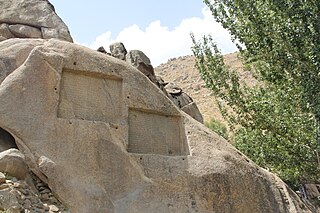 W
WElamite, also known as Hatamtite, is an extinct language that was spoken by the ancient Elamites. It was used in present-day southwestern Iran from 2600 BC to 330 BC. Elamite works disappear from the archeological record after Alexander the Great entered Iran. Elamite is generally thought to have no demonstrable relatives and is usually considered a language isolate. The lack of established relatives makes its interpretation difficult.
 W
WThe Caylus vase is a jar in alabaster dedicated in the name of the Achaemenid king Xerxes I in Egyptian hieroglyph and Old Persian cuneiform. It was the key element in confirming the decipherment of Old Persian cuneiform by Grotefend, through the reading of the hieroglyphic part by Champollion in 1823. It also confirmed the antiquity of phonetical hieroglyphs before the time of Alexander the Great, thus corroborating the phonetical decipherment of the names of ancient Egyptian pharaohs. The vase was named after Anne Claude de Tubières, count of Caylus, an early French collector, who had acquired the vase in the 18th century, between 1752 and 1765. It is now located in the Cabinet des Médailles, Paris.
 W
WCuneiform is a logo-syllabic script that was used to write at least fifteen languages of the Ancient Near East. The script was in active use from the early Bronze Age until the beginning of the Common Era. It is named for the characteristic wedge-shaped impressions which form its signs. Cuneiform was originally developed to write the Sumerian language of southern Mesopotamia. Along with Egyptian hieroglyphs, it is one of the earliest writing systems.
 W
WDarius the Great's Suez Inscriptions were texts written in Old Persian, Elamite, Babylonian and Egyptian on five monuments erected in Wadi Tumilat, commemorating the opening of the "Canal of the Pharaohs", between the Nile and the Bitter Lakes.
 W
W W
WGanjnameh is located 12 km southwest of Hamadan in western Iran, at an altitude of c. 2000 meters across Mount Alvand. The site is home to two trilingual Achaemenid cuneiform inscriptions. The inscription on the upper left was created on the order of Achaemenid King Darius the Great and the one on the right by his son King Xerxes the Great.
 W
WThe Jar of Xerxes I is a jar in calcite or alabaster, an alabastron, with the quadrilingual signature of Achaemenid ruler Xerxes I, which was discovered in the ruins of the Mausoleum at Halicarnassus, in Caria, modern Turkey, at the foot of the western staircase. It is now in the British Museum.
 W
WKul-e Farah Is an open air sanctuary situated in the Zagros mountain valley of Izeh/Mālamir, in south-western Iran, c. 800 meters over sea level. Six Elamite rock reliefs are located in a small gorge marked by a seasonal creek bed on the plain's east side of the valley, near the town of Izeh in Khuzestan.
 W
WLinear Elamite is a Bronze Age writing system used in Elam between 2300–1850 BCE, known mainly from a few monumental inscriptions. It was used contemporaneously with Elamite cuneiform and possibly records the Elamite language.
 W
WThe Proto-Elamite period, also known as Susa III, is the time from ca. 3100 BC to 2700 BC in the area of Elam. In archaeological terms this corresponds to the late Banesh period, and it is recognized as the oldest civilization in Iran.
 W
WThe Xerxes I inscription at Van, also known as the XV inscription, is a trilingual cuneiform inscription of the Achaemenid King Xerxes I. It is located on the southern slope of a mountain adjacent to the Van Fortress, near Lake Van in present-day Turkey. When inscribed it was located in the Achaemenid province of Armenia. The inscription is inscribed on a smoothed section of the rock face near the fortress, approximately 20 metres above the ground. The niche was originally carved out by Xerxes' father, King Darius, but he left the surface blank.